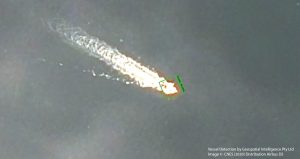The detection of unlawful fishing, oil spills and other illicit activity may require area monitoring or a quick reaction to a looming hazard. Geospatial Intelligence (GI) uses Artificial Intelligence (AI) algorithms on earth observation imagery, fused with Satellite Automatic Identification Systems (AIS), to track vessels and report on their activity. Our services allow clients to enhance safety at sea, and the protection of marine resources.
New machine learning and AI technologies (Machine Intelligence) are increasingly being applied to remotely sensing data, especially satellite imagery. Utilising MI is not only a computationally efficient choice of technology, but it is also a highly effective way of applying algorithms to a wide and diverse range of environments, i.e. from busy maritime ports, to open ocean transport routes. MI algorithms are dependent on high quality training datasets. This can either be gathered manually, through a trusted source, or developed using a combination of remote sensing methods. An alternative to these traditional techniques is open source intelligence. GI has developed a series of tools to geo-reference unstructured open source data for this purpose and has effectively used these techniques in biosecurity and illegal fishing applications.



Utilising the benefits of MI technology combined with earth observation data and additional data sources, insightful information for maritime domain awareness can be acquired. With extensive experience in the maritime industry, GI understands how fusing multi-INT data sources can produce more reliable, accurate and valuable information.
AI technology enables more cost effective and timely maritime surveillance tasks by reducing analysis time. GI’s latest AI vessel detection system can produce vessel detection reports over large very high-resolution satellite imagery scenes in seconds, where a purely human based analysis might take hours. For example, the vessel detection images below are a result of GI’s AI algorithm running over a 37 sq.km. section of ocean in 36 seconds.


Read our previous article Maritime Domain Awareness Detection and Modelling for a recent example of how GI detected and modelled the effects of the APL ENGLAND incident.
